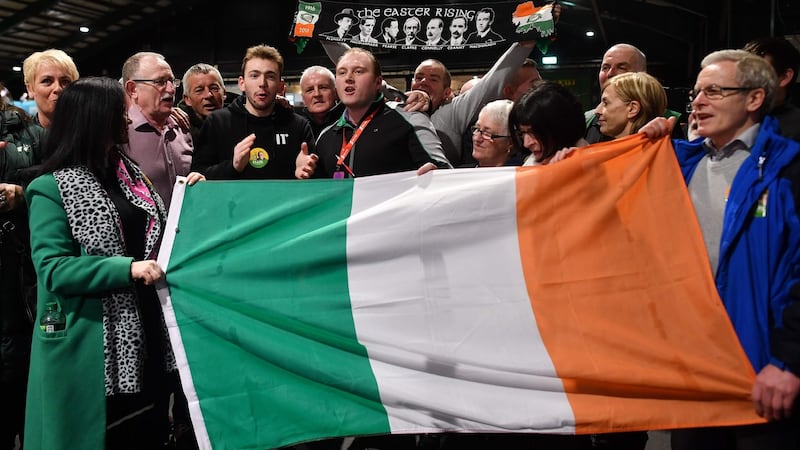Walking around the streets of my Dublin neighbourhood on Saturday, as the nation’s votes were being counted, I saw something I had never seen before: in some houses, tricolours were being displayed, discreetly in upstairs bedroom windows, or not so discreetly.
This is not the kind of neighbourhood where tricolours are unfurled before the Republic of Ireland plays a World Cup qualifying match, or even on St Patrick’s Day. It made me realise that indeed, a sea change has taken place in Irish politics. And part of it is the inevitability of Sinn Féin and Fianna Fáil coming to some kind of governing arrangement, due to one, profound unifying principle: it’s the republic, stupid!
This shouldn’t be surprising to anyone. In the hung parliament of 1982, the Fianna Fáil leader Charlie Haughey did a deal to form a government with Tony Gregory, an Independent left-wing TD from Dublin’s inner city.


When people expressed their surprise at the deal, Gregory pointed out the obvious. Despite their ideological differences, he and Haughey had something in common: they were both republicans. For this reason he chose Haughey over the rival coalition of Fine Gael and Labour. He was, as it happens, proven right.
The Haughey-Gregory government soon collapsed, and the Fine Gael-Labour coalition quickly moved to stop building the housing programme Gregory and Haughey had agreed on. Whatever else it may be, Irish republicanism does have a left-wing, public-good aspect.
Republicanism trumps everything
To me, republicanism is one of those mystical beliefs which is impossible to understand intellectually, but whose emotional reality for many has to be acknowledged. It explains many things. In the late 1970s and early 1980s myself and my friend Dermot Bolger started to publish works by Francis Stuart, a writer who was, to say the least, controversial, but from whom I learned an important lesson about republicanism.
Stuart, who was married to Iseult Gonne, daughter of Maud Gonne and muse to WB Yeats, had joined the republican side in the Civil War, despite being of Irish Protestant descent, and educated at Rugby, the English public school. Stuart ended up living in Nazi Germany during the second World War, broadcasting to neutral Ireland. Here, he spent much time with Frank Ryan, the leader of the Irish left who had gone to Spain to fight the fascist forces in the Spanish Civil War, been taken prisoner, and eventually ended up in wartime Berlin as a kind of official liaison between the IRA and Nazi Germany.
At the time, I was writing about Frank Ryan, and was baffled by their friendship and above all, by their actions, as they seemed to be collaborating with the Nazi government. I had many long and illuminating discussions with Stuart but was still left with many questions. It was only much later that I realised my mistake. I was trying to look at these events in terms of European ideas like communism and fascism. But though Stuart and Ryan loathed each other, and held opposing political positions in many areas, they still had an indissoluble bond: they were both Irish republicans. And republicanism trumps everything else.
Same gene pool
This may be the moment to rehearse some obvious facts familiar to every Irish school child. Fianna Fáil is officially Fianna Fáil – The Republican Party, and came into being in 1926 as a splinter group from Sinn Féin. The two parties have risen out of the same gene pool. Which is why many people, like myself, were left staring in disbelief at the TV screen as Michael Martin promised not to entertain coalition with Sinn Féin after the election. Even within Fianna Fáil did anyone believe it, or was it regarded as a cynical attempt not to be outflanked by Fine Gael, and accepted as such?
As the results came in, it was increasingly obvious that this was on the cards all the time. It may even work out well: after all, Fianna Fáil has always had a leftist, populist aspect, and to give them their due, they were responsible for massive house-building programmes in the last century at a time when, unlike today, there were few available resources. Maybe it would be profitable to think of a Fianna Fáil and Sinn Féin coalition as a single ruling government party, with a right wing and a left wing acting as a balance and control to each other.
It is clear now that it was tactically brilliant of Sinn Féin not to put nationalist aspirations to the fore in their political campaign. In recent days I have spoken to many young people who voted for Sinn Féin, who have only the vaguest notion of their nationalist ideology. They cleverly concentrated on the open goals of change in housing and health, glaring open goals in which the historic party of the left tragically seemed unable to score. In pursuit of their nationalist goals a coalition with Fianna Fáil is the obvious step. And if Fianna Fáil fail doesn’t form some kind of governing relationship with Sinn Féin, I’ll eat my tricolour.
Michael O’Loughlin is a writer and poet










